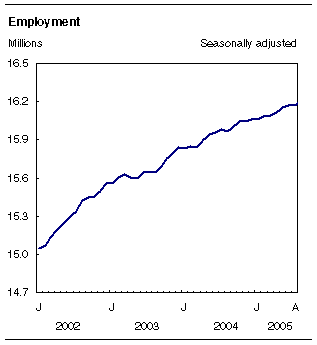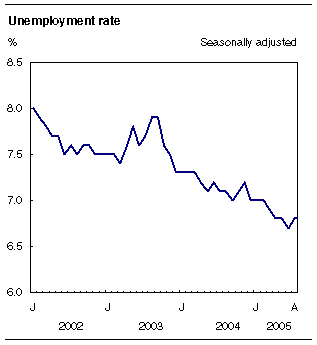
















 |
|
 |                |
Information identified as archived is provided for reference, research or recordkeeping purposes. It is not subject to the Government of Canada Web Standards and has not been altered or updated since it was archived. Please "contact us" to request a format other than those available.

|

Friday, September 9, 2005 Labour Force SurveyAugust 2005Employment increased by 28,000 in August, the result of gains in full-time work. This brings the increase in employment over the past 12 months to 234,000 (+1.5%). The unemployment rate remained unchanged from July at 6.8%. 
The rate of growth in employment in Canada in the last year has been similar to that in the United States (+1.7%). Full-time employment increased by 36,000 in August. Over the past 12 months, all of the increase in employment has come from full-time work (+242,000 or 1.9%). Full-time jobs for youthsYouth employment made modest gains in August, as an increase in full-time jobs (+20,000) was partially offset by a drop in part time. Compared to August 2004, youth employment has increased by only 0.9%. Over the same period, the youth unemployment rate edged down 1 percentage point to 12.2%. Employment for adult men (aged 25 and over) was virtually unchanged in August. Over the past 12 months, employment for adult men has increased by 112,000 (+1.5%). In August, the unemployment rate for this group remained unchanged at 5.7%. While employment for adult women was little changed in August, their unemployment rate edged up 0.2 percentage points to 5.7%, the result of increased labour force participation. Compared to a year ago, an additional 99,000 (+1.6%) adult women were employed. Job market weakens for older studentsThe summer of 2005 proved to be tougher for students looking to get some labour market experience. The share of students working in August (54.8%) was down one percentage point from a year earlier, driven by lower employment rates for 17 to 19 and 20 to 24-year olds. However, students who did find work were more likely to be working full time. From May to August, the Labour Force Survey collects labour market information about young people aged 15 to 24 years who were attending school full-time in March and intend to return to school in the fall. The published estimates are not seasonally adjusted; therefore comparisons can only be made on a year-over-year basis. 
Construction gains in Quebec and AlbertaThe construction industry led employment growth in August adding 32,000 more jobs, largely in Quebec (+16,000) and Alberta (+13,000). Since the start of the year, construction employment has grown 4.1% — still strong, but at a reduced pace from this time last year. Employment increased in business, building and other support services in August (+14,000), largely in security services. Professional, scientific and technical services employment was up 12,000 in August, driven by gains in architectural, engineering and design services. An increase of 14,000 jobs was reported for the transportation and warehousing industry in August, mostly in truck transportation. Agricultural employment decreased by 8,000 in August, despite the fact that farming as a main job has increased since the start of the year. Employment also declined in information, culture and recreation (-18,000) in August, primarily in broadcasting and telecommunications and in amusement, gambling and recreation. Employment in information, culture and recreation is down by 5.8% since August 2004. While there was only a slight decline in manufacturing employment in August, the number of factory jobs has fallen by 4.7% or 108,000 since August 2004. The manufacturing industry in Ontario has been hardest hit with job losses of 48,000, followed by Quebec (-19,000), Alberta (-18,000) and British Columbia (-15,000). More jobs in QuebecEmployment in Quebec continued to rise in August (+17,000) bringing gains over the past three months to 58,000. August's employment increase was driven by construction, educational services and transportation and warehousing. Employment increased by 5,000 in Nova Scotia, causing the unemployment rate to drop 0.7 percentage points to 7.2% in August, the lowest in nearly three decades. Job increases were mainly in business, building and other support services and in transportation and warehousing. Employment in Ontario was little changed in August and the unemployment rate held steady at 6.6%. In the past 12 months, 88,000 jobs (+1.4%) have been added, driven by large gains in trade and educational services. Despite little change in employment in August, the unemployment rate in British Columbia dropped 0.4 percentage points to 5.8%. In the past 12 months, British Columbia has experienced the fastest rate of employment growth of all Canadian provinces (+3.4%). Construction and educational services has contributed to this rapid growth, as have several service industries. The unemployment rate in Alberta edged up 0.3 percentage points to 3.9% in August. Although employment was essentially unchanged in August, it has increased by 20,000 (+1.1%) over the last year. Employment in natural resources has grown by 15.2% in the last 12 months and by 13.9% in professional, scientific and technical services. In Newfoundland and Labrador, employment fell by 5,000 in August, pushing the unemployment rate up 2.3 percentage points to 16.7%. Declines were widespread across the service sector. In Saskatchewan, employment fell by 3,000 in August, continuing the weakness since the start of the year. Declines in accommodation and food services and educational services contributed to the drop in August. Employment in the other provinces was relatively unchanged. Available on CANSIM: tables 282-0001 to 282-0042, 282-0047 to 282-0064, 282-0069 to 282-0096 and 282-0098. Definitions, data sources and methods: survey number 3701. Available at 7:00 a.m. on our Web site. From the home page, choose Today's news releases from The Daily, then Latest Labour Force Survey. A more detailed summary, Labour Force Information, is available today for the week ending August 20 (71-001-XIE, $9/$84). LAN and bulk prices are available on request. Data tables are also available in the Canadian Statistics module of our Web site. The next release of the Labour Force Survey will be on Friday, October 7. For general information or to order data, contact Client Services (1-866-873-8788; 613-951-4090; labour@statcan.gc.ca). To enquire about the concepts, methods or data quality of this release, contact Vincent Ferrao (613-951-4750), Danielle Zietsma (613-951-4243), Labour Statistics Division.
| |||||||||||||||||||||||||||||||||||||||||||||||||||||||||||||||||||||||||||||||||||||||||||||||||||||||||||||||||||||||||||||||||||||||||||||||||||||||||||||||||||||||||||||||||||||||||||||||||||||||||||||||||||||||||||||||||||||||||||||||||||||||||||||||||||||||||||||||||||||||||||||||||||||||||||||||||||||||||||||||||||||||||||||||||||||||||||||||||||||||||||||||||||||||||||||||||||||||||||||||||||||||||||||||||||||||||||||||||||||||||||||||||||||||||||||||||||||||||||||||||||||||||||||||||||||||||||||||||||||||||||||||||||||||||||||||||||||||||||||||||||||||||||||||||||||||||||||||||||||||||||||||||||||||||||||||||||||||||||||||||||||||||||||||||||||||||||||||||||||||||||||||||||||||||||||||||||||||||||||||||||||||||||||||||||||||||||||||||||||||||||||||||||||||||||||||||||||||||||||||||||||||||||||||||||||||||||||||||||||||||||||||||||||||||||||||||||||||||||||||||||||||||||||||||||||||||||||||||||||||||||||||||||||||||||||||
|
|
|